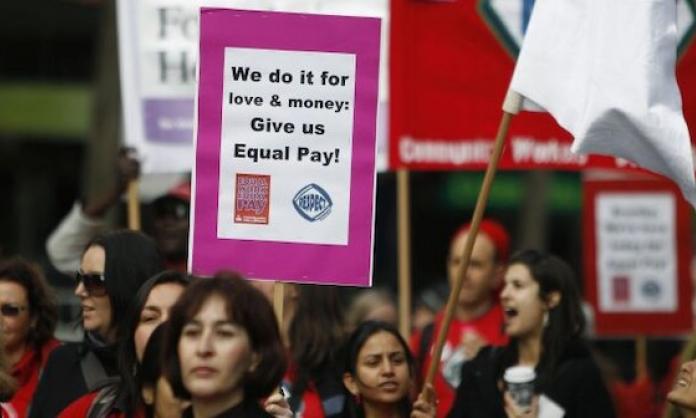Sexism is so fundamental to our existence that we are not even aware of it much of the time.
It starts from before we are even born. An experiment described by Annie Murphy Paul in her book Origins highlights the different ways pregnant women interpret the movement of their babies in utero. Those who knew they were expecting a boy were more likely to use words like “energetic”, “vigorous” and “jabbing” to describe the movement, while for girls it was “gentle”, “rolling” and “quiet”.
This sort of unconscious bias shapes and curtails women’s potential throughout their lives. In her book Delusions of Gender, neuroscientist Cordelia Fine describes an experiment which showed that simply reminding university students about whether they’re a man or a woman at the beginning of a test, by asking them to tick a box, reduces women’s performance on the test compared to that of men; in the absence of such a reminder, men and women perform equally well. Even the “feminine” or “masculine” nature of the décor in the room where the test is held has a measurable impact on performance. If such subtleties can have a statistically significant effect, just imagine the cumulative effect of this conditioning over a lifetime.
The sexist bias that plagues data collection and design has been documented by Caroline Creado Perez in Invisible Women: Exposing data bias in a world designed for men. Every area of design and technology is affected, from medical testing and drug development to building design, workplace temperature and tool size, all of which have wide-ranging and material effects on women’s health and lives. The male bias built into car safety testing, for example, means women are 49 percent more likely to be seriously injured in car accidents and 17 percent more likely to die than men.
Then there are all the manifestations of sexism that we are conscious of, like unequal pay, lack of adequate maternity leave, limited access to child care, greater poverty on average for women throughout their lifetimes, greater risk of violence and death from intimate partners, sexualisation and objectification in daily life as well as in popular culture and advertising, to name just a few.
There is not an aspect of life that isn’t affected by the gendered, and therefore sexist, nature of society in some way, from the most personal to the most public.
So what can be done about this so all-pervasive form of inequality?
First, we—women and men—need to become as conscious as we can of sexism in our daily lives and strive to minimise it as best we can. We want women to be able to reach their potential and participate in whatever area of society, work and culture they want as equals. That means being sensitive to how the minutiae of behaviour—things like who dominates conversations and who gets listened to and taken notice of—affect women, who are used to being ignored, dismissed and generally treated as less important than men. It means treating women as equals, not sex objects, there merely to be admired or preyed on by men. And it means taking pro-active measures to push against the various subtle ways sexism shapes all sorts of human interactions.
But even if we do everything we can to be alert to everyday sexism, it doesn’t alter the social reality around us that is reinforcing sexist ideas and norms as fast as we can reject them.
So we also need a strategy for changing society and the inequalities that are structured into it and which every day normalise the subordinate position of women.
In the immediate term, this means policies and services that enable women to participate as equals in paid work and the public sphere as much as possible—free, accessible child care and aged care, unlimited maternity leave, greater scrutiny of hiring and promotion to reduce discrimination against women, as well as higher wages in industries dominated by women, to name just a few.
But on their own, these measures merely support women to undertake paid work more easily while they continue to take primary responsibility for caring as well. Hence the notorious “double burden” that plagues working women’s lives. In themselves, such reforms don’t challenge the idea that women are naturally nurturing and better suited to caring for others than men, who, by their nature, belong in positions of power.
So, important as measures that enable women to participate fully in paid work and the public sphere are, they are not sufficient to bring about genuine equality or liberation. To achieve this, we need more radical change. In particular, we need to transform the way work is done, including breaking down the division between work in the formal economy and caring work, and the subordination of all work to profit making and capital accumulation.
As long as most of us are expected to spend 40 hours or more a week performing waged labour—during which our “real” lives are on hold and we are under the control of a boss and doing work to generate profit for those who hire us rather than doing what is needed to keep ourselves and those around us alive, healthy and happy—the division of labour that so effectively supports this economic model will endure. Indeed, this is why it persists more then 50 years after most formal rights for women were won, including the right to equal pay, the right to work while married, the right to financial autonomy, the right to divorce and reproductive freedom.
The bosses rely on the existence of a sub-class—women— to take responsibility for ensuring workers are looked after and fit for work, and that new generations of workers are produced who are willing and able to work. Women perform the majority of this work for free out of a sense of duty and because they genuinely care about the wellbeing of those around them. But the value to the bosses, who rely on that work to provide a productive workforce, is nevertheless enormous.
A 2017 PWC report, “Understanding the unpaid economy”, found that unpaid work is worth $2.2 trillion to the Australian economy, equivalent to a third of GDP. Unpaid child care is the largest contributor, worth 25 percent of GDP, and would be by far the biggest industry in Australia if it was part of the formal economy. Domestic household tasks, including cooking and cleaning, are the next biggest category of unpaid labour.
Having more women in the halls of power won’t be enough to change this. The halls of power are dedicated to strengthening the economy—i.e. generating more GDP through better exploiting workers and maximising the profits of business—and are dominated by the economic interests of the powerful few who control major corporations and industries. Waged labour and the status quo that ensures exploitation continues smoothly serve their interests, and those who challenge that soon find themselves on the outer. So while women have as much right as men to occupy parliaments and boardrooms, this is not a strategy for liberating women.
To bring about the radical change that is necessary, we need to orient to an alternative source of power: the power the working class has collectively to challenge and transform society by mobilising at the point of production. Workers make everything, and they do it together. Rather than bosses directing this process, workers have the potential to decide democratically how and what to produce and for what purpose.
Work and production could and should be reorganised to meet need—including the social need to care for everyone as well as the need to protect the planet from destruction. And because it could only be done collectively, cooperation, solidarity and fostering mutual respect are necessary to help strengthen working-class power. This is why we can be confident that the prejudice and inequality that are so rampant in capitalist society would be organically challenged and eventually overcome in the course of workers fighting for a socialist society, as has happened historically at high points of workers’ struggle.
Working-class women aren’t necessarily conscious of the need for this sort of radical change to solve the problems they experience as a result of capitalism’s need both to exploit them and maintain their caring role. And nor are most male workers, who likewise have an interest in challenging waged labour and exploitation. But the reality is this is the only way to bring about a society of gender, as well as broader, equality, and to have a society that can meet people’s needs as a matter of priority, not as an afterthought or a ritualised hand-wringing every year on International Women’s Day.
To get there, we need to start with rebuilding working-class consciousness and power from the bottom up. This is the radical origin of what was originally known as International Working Women’s Day when it was founded by socialist women in 1910 and celebrated under the slogan “The vote for women will unite our strength in the struggle for socialism”.
There is no easy way to do that, and we are currently a long way from the sort of consciousness and organisation needed to overthrow this system of inequality and prejudice. But if we want to avoid the cynicism or despair that comes from watching politicians carp on about women’s empowerment while they maintain policies that keep women down, or CEOs raising champagne glasses at International Women’s Day breakfasts while women languish on low wages in low-status jobs, we need some idea of what could actually transform the position of women. And we need to fight for those ideas wherever we are—at work, on university campuses and in every other area of life—and get together with other people doing the same, so that we can maximise our impact and form a larger pole of attraction for people who are continually pushed to radical conclusions by the injustices and atrocities of the capitalist system. That is the small but important step we can take towards women’s liberation, and the liberation of all humanity, in the here and now.











